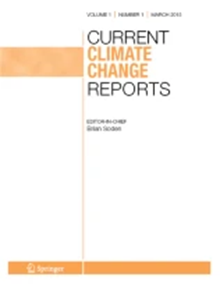A Review of Abrupt Permafrost Thaw: Definitions, Usage, and a Proposed Conceptual Framework.
IF 10.3
1区 地球科学
Q1 METEOROLOGY & ATMOSPHERIC SCIENCES
引用次数: 0
Abstract
Purpose of Review We review how 'abrupt thaw' has been used in published studies, compare these definitions to abrupt processes in other Earth science disciplines, and provide a definitive framework for how abrupt thaw should be used in the context of permafrost science. Recent Findings We address several aspects of permafrost systems necessary for abrupt thaw to occur and propose a framework for classifying permafrost processes as abrupt thaw in the future. Based on a literature review and our collective expertise, we propose that abrupt thaw refers to thaw processes that lead to a substantial persistent environmental change within a few decades. Abrupt thaw typically occurs in ice-rich permafrost but may be initiated in ice-poor permafrost by external factors such as hydrologic change (i.e., increased streamflow, soil moisture fluctuations, altered groundwater recharge) or wildfire. Summary Permafrost thaw alters greenhouse gas emissions, soil and vegetation properties, and hydrologic flow, threatening infrastructure and the cultures and livelihoods of northern communities. The term 'abrupt thaw' has emerged in scientific discourse over the past two decades to differentiate processes that rapidly impact large depths of permafrost, such as thermokarst, from more gradual, top-down thaw processes that impact centimeters of near-surface permafrost over years to decades. However, there has been no formal definition for abrupt thaw and its use in the scientific literature has varied considerably. Our standardized definition of abrupt thaw offers a path forward to better understand drivers and patterns of abrupt thaw and its consequences for global greenhouse gas budgets, impacts to infrastructure and land-use, and Arctic policy- and decision-making. Supplementary Information The online version contains supplementary material available at 10.1007/s40641-025-00204-3.冻土突然融化的综述:定义、用法和建议的概念框架。
我们回顾了“突然融化”在已发表的研究中是如何使用的,将这些定义与其他地球科学学科中的突然过程进行比较,并为如何在永久冻土科学背景下使用突然融化提供了一个明确的框架。最近的发现我们讨论了发生突然融化所必需的永久冻土系统的几个方面,并提出了一个将未来永久冻土过程分类为突然融化的框架。基于文献综述和我们的集体专业知识,我们提出突然解冻是指在几十年内导致实质性持续环境变化的解冻过程。突然解冻通常发生在富冰永久冻土中,但也可能由诸如水文变化(即河流流量增加、土壤湿度波动、地下水补给改变)或野火等外部因素在贫冰永久冻土中引发。永久冻土解冻改变了温室气体排放、土壤和植被特性以及水文流动,威胁到基础设施、北部社区的文化和生计。“突然融化”一词在过去二十年中出现在科学论述中,以区分快速影响大深度永久冻土的过程,如热岩溶,与更渐进的,自上而下的融化过程,影响数年至数十年的近地表永久冻土厘米。然而,对于突然解冻并没有一个正式的定义,它在科学文献中的用法也有很大的不同。我们对突然融化的标准化定义为更好地理解突然融化的驱动因素和模式及其对全球温室气体预算、对基础设施和土地利用的影响以及北极政策和决策的影响提供了一条道路。补充信息在线版本提供补充资料,网址为10.1007/s40641-025-00204-3。
本文章由计算机程序翻译,如有差异,请以英文原文为准。
求助全文
约1分钟内获得全文
求助全文
来源期刊

Current climate change reports
Environmental Science-Global and Planetary Change
CiteScore
20.30
自引率
0.00%
发文量
10
期刊介绍:
Current Climate Change Reports is dedicated to exploring the most recent research and policy issues in the dynamically evolving field of Climate Change. The journal covers a broad spectrum of topics, encompassing Ecological Impacts, Advances in Modeling, Sea Level Projections, Extreme Events, Climate Feedback and Sensitivity, Hydrologic Impact, Effects on Human Health, and Economics and Policy Issues. Expert contributors provide reviews on the latest research, assess the effectiveness of available options, and engage in discussions about special considerations. All articles undergo a thorough peer-review process by specialists in the field to ensure accuracy and objectivity.
 求助内容:
求助内容: 应助结果提醒方式:
应助结果提醒方式:


